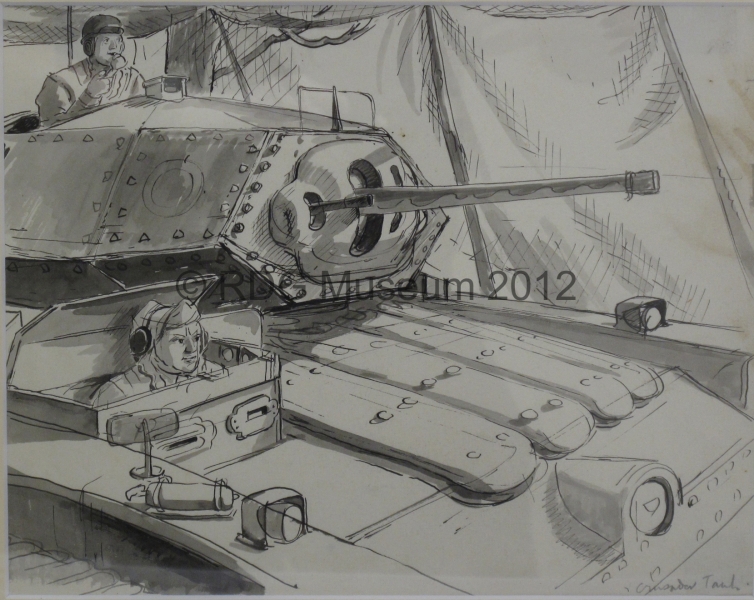


After being withdrawn to Britain during the fall of France in the summer of 1940, the 4th/7th Royal Dragoon Guards were to endure four long and sometimes frustrating years of training and re-equipping. Much of the British Army's heavy equipment had been left behind on the coast of France, including the majority of its tanks; as priorities changed and changed again, British producers worked hard to keep pace. Among the vehicles entering production to re-arm the badly denuded British Army was the Tank, Cruiser, Mk. V, otherwise known as the Covenanter.
Unfortunately, the Covenanter's design included an unusual cooling system; since the large engine took up almost all of its compartment at the rear of the tank, the radiator was mounted at the front. (It can be seen in Payne's painting, beneath the four long mushroom vents forward of the turret, receiving a perhaps none-too-affectionate glance from the driver.) Because the hot radiator pipes ran through the fighting compartment, the crew often became uncomfortably hot even in the British climate; sending them to North Africa with the Covenanter was, therefore, out of the question. Covenanters were instead used in training roles in the British Isles, and could frequently be seen roaming the countryside, or aiding recruitment by parading impressively through towns.
The Covenanter never saw active service as a gun tank, and was declared obsolete in 1943. Some were later converted to other roles, including work as mobile Observation Posts (OPs) for Royal Artillery Forward Artillery Controllers, and as bridgelaying tanks, used for crossing gaps.
This painting thus depicts the 4th/7th Royal Dragoon guards during the difficult period of British recuperation after the near-catastrophe of Dunkirk, when the fate of Britain and the British Empire hung in the balance. At this time, the war was looking bleak for the Allies. France had fallen. Hitler had invaded the USSR in 1941, and had succeeded in occupying much of that vast country's populous and fertile Western lands. By December, the Wehrmacht had caught sight of Moscow for the first, and the last, time, but the outcome of the war in the East remained just as uncertain as that in the West.America remained officially neutral, only entering the war as a result of the Japanese surprise attack on Pearl Harbor, carried out on December 7th of that year.The simultaneous and ferocious assaults on Britain's imperial possessions in the Far East, along with the destruction of the two battleships Prince of Wales and Repulse, only darkened an already black horizon. Meanwhile, 1941 also saw the arrival in North Africa of Erwin Rommel and the famed Afrika Korps, who went on to inflict a series of heavy defeats on the hitherto victorious British Eighth Army.
For the 4th/7th Royal Dragoon Guards, 1941 was a year of training, recruitment, and re-equipment, growing in readiness for the hoped-for, but still far-off, British counteroffensives against the Axis.